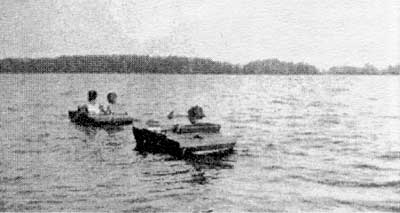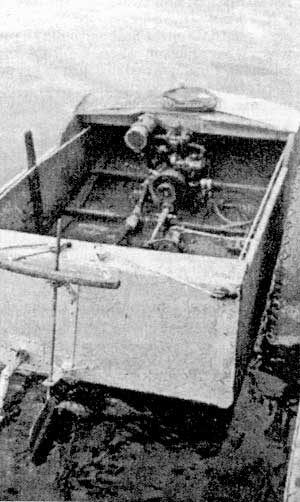My First Full Sized Boat
By Bradford Lyttle
(Excerpted
from Messing Around In Boats)
(click
here for more information about MAIB)
Reading MAIB
has made me reflect on how I became involved with small boats.
Two influences have occurred to me. One was the summer home
that our family had on the Canadian side of the St. Lawrence
River in the Thousand Island area. We called this property "Greyrock,"
since it's main cottage was built on a granite boulder. We always
had small boats there, St. Lawrence skiffs, canoes, punts, sailboats,
and eventually outboards. A number of the people who visited
us built and repaired boats as a hobby. I was always around
these people and their tools and became involved in boat repairing.
The second influence came from a peculiarity
of living in the Hyde Park neighborhood on the south side of
Chicago that included Jackson Park. I was brought up there in
the earliest years of the Great Depression. Jackson Park was
on Lake Michigan and had a yacht basin, but there weren't many
people then who had the money to own and maintain yachts. Therefore,
the city built a model boat basin nearby. The basin was a round
concrete pool about 200' in diameter and about 2' deep. Particularly
on weekends, people would come from all over the city to try
out model boats in the basin. There were many beautiful model
yachts that sailed gracefully and a number of model steam launches
that displayed exquisite craftsmanship. My parents often look
me to the model yacht basin to sail my own boats and look at
the others.
Also about that time an odd toy was popular.
These were "Pop Pop" boats. (Editors Note: See Derek
Waters' excellent article
on building these fun little boats) Pop Pop boats were made
of tin and usually were no longer than 8". The boats were
driven by a primitive steam engine that consisted of a boiler
with a thin, flat, metal top and two tubes that went from the
bottom of the boiler out the end of the boat. As I recall, you
filled the boiler by holding the tubes under a faucet. Then
you put the boat in the water and a candle under the boiler.
The candle heated the water in the boiler until it turned into
steam. The steam expanded, pushing up the flat metal top of
the boiler, and then "popped" out the tubes in back,
propelling the boat forward. As I recall, it was never necessary
to refill the boiler. After each "pop" fresh water
was drawn into the tubes. I often played with Pop Pop boats
in our bathtub.
As I grew older other kinds of model boats came
to interest me. One kind were powered by rubber bands. These
usually were submarines, were made of wood, and powered by tin
propellers turned by twisted rubber bands. As I recall, the
boats also had planes on their front and stern that could be
adjusted to force the boats under water. When the rubber bands
were fully wound up. Some of these submarines could travel under
water horizontally 15' or 20' before their power was exhausted.
A more sophisticated submarine, that I think
I first saw in Popular Mechanics Magazine, was powered by calcium
carbide, the chemical that, when mixed with water, produces
acetylene. The submarines were made of tin, their hulls were
tin cans, and other pieces of tin were soldered on. In their
conning tower they had a container for a few pieces of calcium
carbide. They also had a valve in their bottom and a stern facing
water ejection nozzle. When the submarine was put into the water,
the valve opened and the boat tended to sink. As water rose
inside the hull, it eventually overflowed into the container
containing the calcium carbide. When this happened, acetylene
was released, the gas drove the water out of the ejection nozzle,
and the submarine moved forward and rose. This cycle might repeat
itself several times before the calcium carbide charge was exhausted.
These boats were particularly challenging because
their means of submerging and rising was rather sophisticated
and required careful adjustment lo work properly. Also, if their
acetylene charge was improperly adjusted, they might not recover
from their last submerging and just sink. Because acetylene
was highly explosive, it was best to use the submarines outdoors,
but I recall testing them a number of times in our bathtub.
That probably was unwise. Sometimes the entire house would smell
of acetylene.
I was probably about 13 before I tried to design
and build my own full-sized boat. A friend had sold me a small,
two-cycle, air-cooled, gasoline engine. I do not know what the
engine originally was designed for. It was well-made, having
a cylinder with a cast iron sleeve and ball hearing crankshaft
journals. I do not think that it had a magneto. It did not have
a cooling fan. Cooling was achieved by the fins on the cylinder.
The motor was a kind of large version of a model airplane engine.
My guess is that it had the power of about a 1.5 hp outboard.

Whirligigs
About the time I obtained the motor, my brother
was building a scow type sailboat. This made me want to design
and build a boat for the motor. My approach to boat design was
about as poor as it could be. Since the motor was air cooled,
it required operation at high speed and was best suited for
a long, sleek, boat like a kayak or a canoe, preferably a boat
where the motor could be mounted with the cooling fins projecting
well above the boat's deck. However, as a child in Canada, I
had often ridden in "whirligigs", double-ended scows
about 6' long and pow-
ered by paddles.
What I wanted to build was a powered whirligig.
This was a bad idea because whirligigs were capable of only
very low speeds, certainly not enough speed to generate the
breeze necessary to cool the motor. Building the powered whirligig
posed a number of technical challenges. One problem was to cool
the motor. Cooling had to be independent of wind generated by
the boat's speed. I could not practically install a cooling
fan. However, I could make the motor water cooled. This involved
fashioning a copper jacket that went around the fins of the
cylinder. Then I had to design and build a pump that could be
operated off the propeller shaft. I made a brass reciprocating
pump that included ball bearing valves. The pump was driven
from the shaft by a small V belt. While the pump worked, a weak
spot was the belt. As I recall, it was sewn together at its
ends with brass wire.
A second problem was to reverse the motor's rotation
so that the motor would drive the little two-bladed propeller
that I had. I did this by gearing the motor to the propeller
shaft.
Other problems were to make a log so that the
1/2" steel propeller shaft could pass through the boat's
bottom, devise a sleering mechanism for the boat, and install
an exhaust pipe. I made the log using poured babbitt metal.

A final construction error was to paint the boat
with creosote in the mistaken belief that this was the only
way to prevent its hull from rotting. Rot may have been prevented,
but paint painted over the creosote would not dry. The result
of all of this engineering and mis-engineering was the strange
looking craft in the picture. The boat worked, but it was slow
and frequently suffered mechanical
breakdowns.
Greyrock was about nine miles east of an island/promontory
named "Grass Creek" that was owned by relatives. Making
this nine mile round trip by water was a kind of annual pilgrimage
for our family. Once the powered whirligig was working, it occurred
to me that it might be able to make the trip.
This was yet another bad idea. A good deal of
the water between the two properties was open and a strong southwest
wind could kick up sizable waves on it. Nevertheless, somehow
I convinced my parents that the boat was equal to the trip and
one bright morning I set off for Grass Creek. As I recall, I
was not wearing a life preserver.
Bateau Channel, the body of water leading to
Grass Creek, had a peculiarity. About five miles west of Greyrock
it divided into a continuation of the channel to the right and
Johnson's Bay to the left. Approaching from the east, the mouth
of the bay was wider than the mouth of the channel. I made the
mistake of turning into Johnson's Bay rather than continuing
up the channel.
It had taken me nearly two hours to make the
dividing point between the two bodies of water. By then the
southwest wind had picked up considerably and the waves in Johnson's
Bay grew bigger and bigger. I was crawling up the Bay, becoming
more and more convinced that somehow I had taken the wrong turn
when, suddenly, the belt on the cooling motor broke. I stopped
the motor and repaired
the belt.
Then, when I tried to start the motor again with
a starling cord that wrapped around a pulley on the motor's
flywheel, I cut one of my fingers to the bone on a piece of
tin associated with the motor's exhaust system. I then was in
a serious fix. The boat was bouncing so much in the waves that
it was shipping water, the motor would not start, and I was
bleeding profusely. I stopped the bleeding by tying a handkerchief
around the cut finger but otherwise did not know what to do.
I was at least a third of a mile from land. The situation could
have ended in a serious tragedy.
While my boat was slowly filling with water,
suddenly a large, double-ended motor launch appeared from the
direction of Howe Island that lay to the south. The launch was
skippered by a local fisherman who had seen my plight and had
come out to offer aid. He took me aboard the launch and towed
my boat back to his dock. There he simply hoisted my boat athwart
the launch and set off with me and the boat to Grass Creek.
I will always remember that launch. It was black and greasy,
covered in places by fish scales and powered by a large, one
lung engine equipped with a compression relief valve for starting.
Every time the engine fired, the sides of the launch would give
inward. The fisherman delivered me and the boat to Grass Creek
and asked no remuneration for his assistance. I will always
remember his kindness. Very possibly he saved my life.
At Grass Creek I made yet another mistake by
putting iodine on the cut. The iodine not only stung fiercely
when applied, but seemed to produce swelling. I spent much of
that night sucking the iodine out of the cut.


